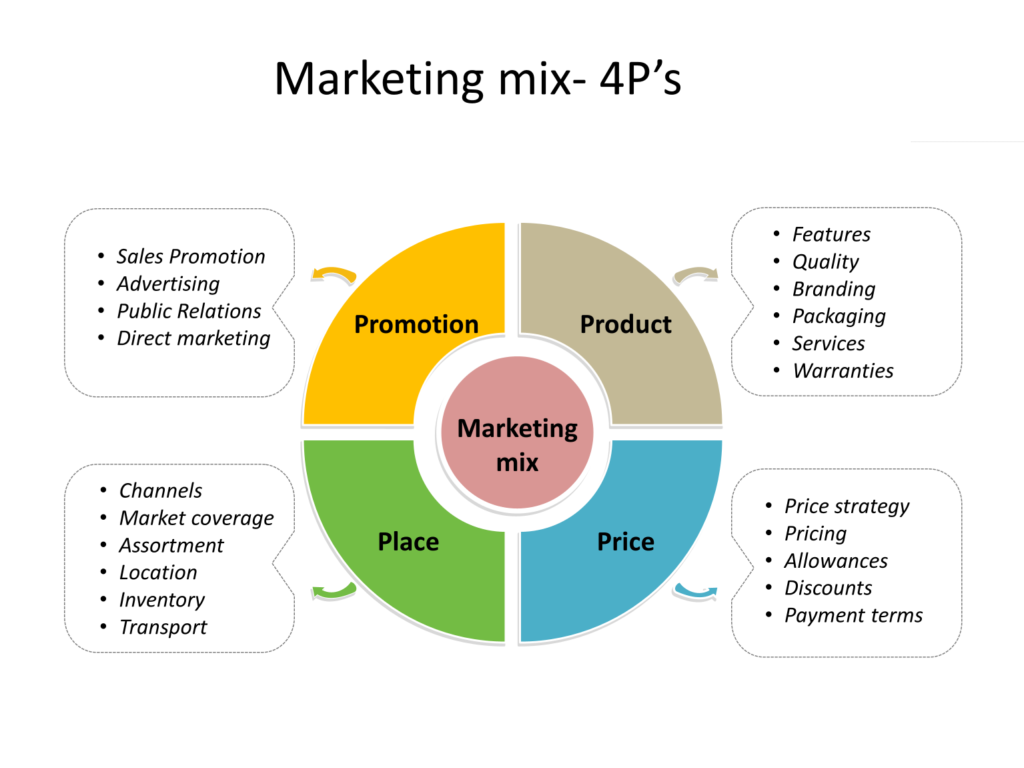The marketing process is the process of analysing market opportunities, selecting target markets, formulating the marketing mix, and managing the marketing effort. Target customers stand at the centre of the marketing process. The marketing process consists of five elements: situational analysis, marketing objectives, marketing strategy, marketing-mix planning, marketing implementation, and marketing control. Without further adieu, let’s see what they are.
- Situational Analysis
- Marketing Objectives
- Marketing Strategy
- Marketing Mix
- Implementation and Control
1. Situational Analysis
The cornerstone of the marketing plan, known as situational analysis, consists of several business-impacting aspects. SWOT, Pestle, Porter’s five forces, and stakeholder analyses are some of them. SWOT (strengths, weaknesses, opportunities, and threats) analysis aims to compile a list of all internal and external strengths, weaknesses, opportunities, and threats to inform strategic planning choices. The purpose of PESTLE, which stands for political, economic, social, technical, legal, and environmental, is to identify all external elements that may impact a company. A situational analysis can help the company comprehend the issues that will affect its future.
2. Marketing Objectives
The objective is the starting point of the marketing process plan. Marketing objectives are goals for the organisation which wants to be successful when encouraging its products or services to customers. They should always be in line with the company’s mission and goals. They are essential because they can show how the company will benefit from marketing, training the employees and managing.
3. Marketing Strategy

A strategy is a long-term plan to accomplish specific goals. Consequently, a marketing strategy is a plan designed to attain marketing goals. In fact, a sound marketing strategy takes care of the mission, vision, key objectives, short-term goals, market research and product branding and positioning. This is primarily achieved through a four-step process used in developing a focused marketing plan, including segmentation, niche, targeting, and positioning. Let’s discuss each step individually:
Segmentation
In profit-driven enterprises, marketing aims to satisfy customer requirements profitably. Therefore, businesses must first determine what and whose demands they can meet. For instance, the personal transportation market comprises individuals who place varying importance on an automobile’s price, speed, safety, status, and appearance. No car can satisfactorily meet all these requirements; compromises must be made. Due to these considerations, a car manufacturer must identify the various consumer preference groups or segments and determine profitably which group(s) it can target.
Also read: 5 Reasons Market Segmentation Can Generate Better Conversions, Higher ROI & A More Profitable Company
Market niches
Segments can be subdivided into even smaller groupings known as “subsegments” or “niches.” A “niche” is a tiny target audience with specific needs. More prominent firms are more inclined to service the larger market segments (mass marketing) and overlook niches. Consequently, smaller organisations that are intimately familiar with a specific niche and specialise in addressing its demands tend to develop.
Targeting
A rising number of businesses are attempting to service “one-to-one” sectors. They aim to tailor their offer and communication to each consumer individually. This is understandable, for example, for huge industrial enterprises with only a few key clients. For instance, the Boeing Company (United States) designs its 747 aircraft uniquely for each of its key customers. With the development of database marketing, which retains individual consumer profiles and purchases histories in firm information systems, it is becoming feasible to serve each client individually. Mass-marketing organisations can personalise their offerings using detailed client information, particularly huge retailers and catalogue houses.
Positioning
Positioning entails developing and presenting a message that clearly positions the company or brand in relation to its rivals. There may be several methods to portray some items as “exceptional.” However, asserting supremacy across several dimensions can be detrimental to a company’s reputation, as consumers are unlikely to think that a single solution can excel in every area. In addition, although the firm may express a specific perspective, customers may perceive a different picture of the company based on their experiences with its product or word-of-mouth.
4. Marketing Mix
A marketing mix is a collection of four elements that may be controlled to meet marketing objectives. Marketing managers utilise this to generate the optimum responses in the target market. Tactical marketing entails the formulation of a marketing mix consisting of four elements — product, price, place, and promotion — that satisfy the strategy for the targeted client demands. Marketing decisions generally fall into the following seven categories or 4Ps of the marketing mix.

- Product
- Price
- Place
- Promotion
Product and packaging
The first component of the marketing mix is the product, which refers to the customer-facing item or collection of services. In the case of a tangible product, like an automobile, a corporation will collect data regarding the features and advantages required by its target market. Before manufacturing a product, the marketer must communicate the clients wants to the product or service designers. In the past, engineers would create a product based on their own tastes, interests, or areas of expertise and then expect marketers to find as many people as possible to purchase it. Instead of relying entirely on engineers’ ideas, modern thinking requires that goods be built with customer input.
Traditional economies frequently produce and use the same things from generation to generation, including food, clothes, and shelter. As economies develop, both the range of accessible products and the products themselves tend to increase and evolve. In today’s industrialised cultures, products experience the same stages of development as humans: birth, growth, maturity, and decline. This continual replacement of old items with new or modified ones has important implications for marketing professionals. New product development covers all facets of a firm, including manufacturing, financing, research and development, personnel management, and public relations.
Also read: What Are The Different Components Of Digital Marketing?
Packaging and branding are also significant aspects of a product’s marketing and are therefore covered in the product aspect of the marketing mix. In some cases, packaging can be as simple as customers in France carrying large, unwrapped loaves of bread. In the majority of developed nations, however, the packaging of goods has become an integral component of the sales process as marketers increasingly define the forms of packaging that will be most appealing to potential buyers. With the proliferation of self-service transactions in both wholesale and retail, the relevance of packaging in product distribution has grown.
Price
The second part of the marketing mix is pricing. Typically, corporations set a price that represents how the market views the quality or performance level of the item. However, marketers are also aware that pricing conveys information to customers about the assumed quality level of a product. However, even if the elite manufacturer could price its product comparably with budget products, it may choose not to since a lower price may imply a lesser level of quality as perceived by the market. In order to increase market share, however, some firms have adopted “the same for less” or “more for the same” pricing, which entails continually giving lower rates than their competitors. This type of discount pricing has drastically reevaluated the marketing tactics of companies in areas such as airlines and medicines, which formerly charged a price premium based on their historical brand power and reputation.
Place
The third component of the marketing mix is place, often known as distribution. When a product travels from manufacturer to consumer, it is considered to be following a distribution channel. A product that is manufactured in France and then distributed in the United States would be deemed to be following a distribution channel as it goes from France to the United States. By utilising this channel, the company ensures that its products are readily available by placing them in places frequented by the target market. Nevertheless, each channel participant can only handle a certain number of items. As a result, some marketers may choose to bypass channel processes and promote directly to customers via factory stores, direct mail, and online shopping.
Promotion
The same basic technique for promoting the product applies to creating service offerings. For instance, an attorney may use the checklist to create a marketing campaign for a new legal service, such as estate planning. Consideration of the who, what, when, and where will make all the difference in how well your product sells. The attorney must develop a contract for its members that specifies which services will be covered, the extent of legal aid provided, etc. In order to create a thriving service mix, the attorney must select characteristics that are desired and anticipated by target consumers; otherwise, the service will not be appreciated in the market.
Promotion, the fourth part of the marketing mix, includes a variety of strategies for engaging with and influencing customers. The primary methods are public relations, advertising, sales promotion, and sales force.
5. Implementation and Control
Marketing plan outcomes can be influenced by effective strategy execution. The management of the planning process can increase the efficiency of implementation by fostering commitment and ownership of the plan and its performance. There are four types of management controls in a marketing process, each serving a distinct function: annual-plan control, profitability control, efficiency control, and strategic control.
Annual-plan control
The cornerstone of annual-plan control is the establishment of monthly or quarterly managerial objectives, such as sales and profitability targets. Organisations use four tools to monitor plan performance.
- The first is sales analysis, which compares sales targets to actual sales and explains or accounts for anomalies.
- A second method is a market-share analysis, which compares a firm’s sales to those of its competitors. Businesses can determine their market share in various ways by comparing their own sales to overall market sales, sales within the market segment, or sales of the segment’s leading rivals.
- Thirdly, the marketing expense-to-sales analysis determines how much a business spends to achieve its sales objectives. It is anticipated that the ratio of marketing costs to sales will change, and companies often specify an acceptable range for this ratio. In contrast, financial analysis calculates these expenditures (and others) from the standpoint of the business. This comprises a proportion of profits to sales (profit margin), profits to assets (return on assets), sales to assets (asset turnover), profits to worth (return on net worth), and assets to worth (financial leverage).
- Lastly, businesses assess customer happiness as a technique for monitoring objective attainment. This type of study is typically less quantitative than those mentioned above and may involve complaint and suggestion systems, customer satisfaction surveys, and a thorough examination of the underlying causes.
Also read: How To Successfully Implement Your Marketing Strategy
Profitability control
Profitability control and efficiency control enable businesses to precisely manage their sales, earnings, and expenses. It illustrates the relative profit-earning potential of a company’s various products and consumer segments. Companies are usually astonished to discover that a tiny portion of their goods and consumers account for most of their income. This information assists a business in allocating its resources and efforts.
Efficiency control
Controlling efficiency requires a microscopic examination of the many components of the marketing mix, such as the sales force, advertising, sales promotion, and distribution. For instance, in order to determine the effectiveness of its sales force, a firm may analyse the number of sales calls each sales representative makes each day, the duration of each contact, and the cost and revenue generated by each call. This study identifies areas where businesses may manage their marketing efforts more effectively and economically.
Strategic control
Strategic control techniques enable managers to analyse the marketing program of an organisation from a critical, long-term viewpoint. This requires a thorough and impartial evaluation of a company’s organisational structure and its capacity to capitalise on its strengths and market prospects. There are two sorts of strategic control instruments available to businesses. First is a marketing-effectiveness rating evaluation, which a firm employs to evaluate itself. A corporation evaluates its marketing performance by analysing its customer philosophy, information, and processes. Secondly, it will assess the effectiveness of its marketing strategy and the integration of its marketing strategies.
Marketing audit
This is a thorough, systematic, impartial, and periodic examination of a company’s strengths with respect to its existing and future markets. Unlike a functional audit, which examines a single marketing activity, this analysis examines all aspects of the marketing, including both macro-factors (demographic, economic, ecological, technological, political, and cultural) and micro-factors (markets, customers, competitors, distributors, dealers, suppliers, facilitators, and the public). Audits of the company’s marketing strategy, marketing organisation, marketing systems, and marketing productivity are conducted. It must be methodical so that tangible conclusions can be drawn from these evaluations. A marketing audit should ideally be conducted by a person, department, or organisation independent of the firm or marketing program. Marketing audits should be performed on a regular basis in order to identify and resolve any issues.
Conclusion
To stay competitive in the market, businesses use marketing strategies. An organisation must research and comprehend the needs and preferences of its customers before developing this policy. A company can streamline its marketing initiatives by creating and following a marketing process. Effective marketing strategies may boost revenue and profit by forging closer ties with customers and clients and enabling the company to better respond to and satisfy customer needs.

















